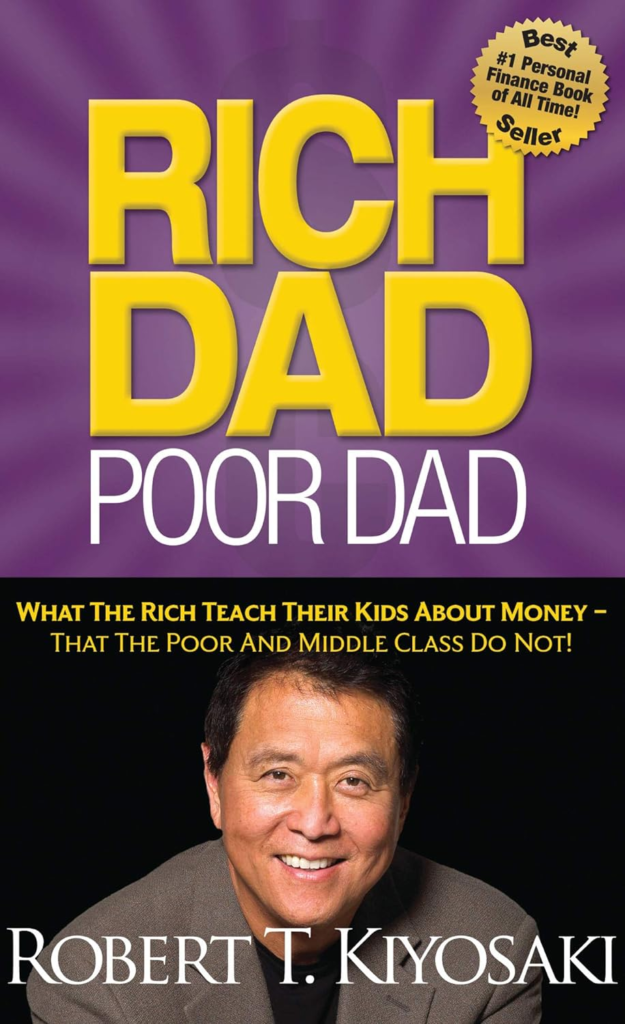
Secrets the Rich Tell Their Families that Many Others Never Learn About Finance
What are your thoughts on living paycheck to paycheck? Do you dream of financial freedom and abundance? Look no further than “Rich Dad Poor Dad,” the groundbreaking book that has transformed countless lives and revolutionized the way we think about money. In this article, we will unveil the secrets of this life-changing book and show you how it can transform your financial journey.
Written by Robert Kiyosaki, “Rich Dad Poor Dad” challenges conventional wisdom about money and offers a fresh perspective on wealth creation. Whether you have read it before or it’s on your to-read list, this article will provide you with valuable insights and actionable strategies to take control of your finances.
Through real-life anecdotes and practical lessons, Kiyosaki shares the contrasting financial philosophies of his two fathers – his real father (the “poor dad”) and his best friend’s father (the “rich dad”). By examining their beliefs and behaviors, he uncovers the key principles that separate the wealthy from the average.
Let’s discuss the world of financial education and discover the secrets that can propel you towards financial freedom. Join us as we explore the transformative power of “Rich Dad Poor Dad” and learn how to create a better financial future for yourself and your family.
Understanding the key concepts of “Rich Dad Poor Dad
At the heart of “Rich Dad Poor Dad” are the contrasting financial philosophies of Kiyosaki’s two fathers – his real father (the “poor dad”) and his best friend’s father (the “rich dad”). The book delves into the lessons Kiyosaki learned from both of them and how they shaped his thinking about money.
The “poor dad” represents the traditional mindset of working hard, getting a good education, and relying on a stable job with a steady paycheck. On the other hand, the “rich dad” embodies an entrepreneurial spirit, emphasizing financial education, investing, and building assets. Through stories and anecdotes, Kiyosaki illustrates how these divergent perspectives can lead to vastly different financial outcomes.
Kiyosaki introduces several key concepts in the book, such as the difference between assets and liabilities, the importance of financial literacy, and the power of passive income. He emphasizes the significance of acquiring assets that generate cash flow, rather than accumulating liabilities that drain resources. By understanding and applying these concepts, readers can start building a solid foundation for their financial future.
The impact of “Rich Dad Poor Dad” on financial mindset
“Rich Dad Poor Dad” has had a profound impact on the financial mindset of millions of readers around the world. It challenges the traditional belief that a high-paying job and a good education guarantee financial success. Instead, it encourages individuals to think differently about money and take control of their financial destiny.
One of the most powerful lessons from the book is the importance of financial education. Kiyosaki argues that our school systems often fail to teach us essential financial skills, leaving many individuals ill-equipped to navigate the complexities of the modern economy. By promoting self-education and the continuous pursuit of financial knowledge, “Rich Dad Poor Dad” empowers readers to become active participants in their financial growth.
The book also emphasizes the value of taking calculated risks and embracing failure as a learning opportunity. Kiyosaki encourages readers to overcome their fear of making mistakes and to develop a mindset that embraces challenges and setbacks. This shift in mentality is crucial in fostering the entrepreneurial spirit necessary for creating wealth and achieving financial independence.
Applying the lessons from “Rich Dad Poor Dad” in real life
While reading “Rich Dad Poor Dad” is a great first step, applying its principles in real life is where the true transformation happens. The book lays out a roadmap for financial success, but it is up to the reader to take action and make necessary changes in their financial habits.
One of the key takeaways from the book is the importance of building assets that generate passive income. This can be achieved through various means, such as investing in real estate, starting a business, or investing in stocks and other financial instruments. By diversifying income streams and focusing on assets that appreciate over time, individuals can move closer to financial independence.
Another critical lesson is the need to control expenses and avoid unnecessary debt. Kiyosaki advises readers to distinguish between good debt (e.g., borrowing to invest in assets) and bad debt (e.g., high-interest consumer debt). By minimizing liabilities and prioritizing wise financial decisions, individuals can free up resources to invest in income-generating assets.
Implementing the lessons from “Rich Dad Poor Dad” requires discipline, patience, and a long-term perspective. It may involve making sacrifices in the short term to achieve financial security and freedom in the future. However, the potential rewards far outweigh the temporary discomfort, as individuals can break free from the cycle of financial stress and start building a life of abundance.
Common misconceptions about financial education debunked by “Rich Dad Poor Dad
“Rich Dad Poor Dad” addresses several common misconceptions about financial education that hold individuals back from achieving financial success. One such misconception is the belief that formal education is sufficient for financial prosperity. Kiyosaki argues that while academic education is valuable, it often falls short in providing individuals with the necessary financial skills to thrive in the real world.
Another misconception debunked by the book is the idea that getting a high-paying job is the key to financial security. Kiyosaki challenges this notion by highlighting the importance of financial independence and the ability to generate income without relying solely on a paycheck. He emphasizes the need to shift focus from working for money to making money work for you.
“Rich Dad Poor Dad” also addresses the misconception that investing is only for the wealthy. Kiyosaki believes that anyone can become an investor and start building wealth, regardless of their current financial situation. The book encourages readers to start small and gradually increase their investments over time, leveraging the power of compound interest to accelerate wealth creation.
By debunking these common misconceptions, “Rich Dad Poor Dad” opens up a world of possibilities and empowers individuals to take control of their financial destiny.
Success stories inspired by “Rich Dad Poor Dad
“Rich Dad Poor Dad” has inspired numerous success stories from individuals who have applied its principles and achieved financial freedom. One such success story is that of Todd, a former employee who transformed his life by implementing the lessons from the book.
Todd had always dreamed of financial independence but found himself trapped in a cycle of living paycheck to paycheck. After reading “Rich Dad Poor Dad,” he realized the importance of building assets and generating passive income. He started investing in real estate and gradually built a portfolio of rental properties. Over time, the rental income surpassed his expenses, allowing him to quit his job and live off the cash flow generated by his investments.
Another success story is that of Sarah, a young entrepreneur who used the book as a guide to start her own business. Inspired by the lessons on financial education and the mindset of an entrepreneur, Sarah leaped and launched a successful online business. By leveraging her passion and skills, she was able to create a thriving venture that provided her with financial stability and the freedom to live life on her terms.
These success stories demonstrate the transformative power of “Rich Dad Poor Dad” and the potential for anyone to achieve financial success by applying its principles. It serves as a reminder that with the right mindset, dedication, and action, anyone can rewrite their financial story.
Tools and resources to enhance financial literacy
“Rich Dad Poor Dad” is just the beginning of the journey towards financial literacy and wealth creation. Fortunately, there are numerous tools and resources available to help individuals enhance their financial knowledge and skills.
One valuable resource is the Rich Dad website (www.richdad.com), which offers a wealth of articles, videos, and online courses on various aspects of personal finance and investing. The website provides a platform for individuals to connect with like-minded individuals, share experiences, and learn from experts in the field.
In addition to the Rich Dad website, several other books and resources complement the lessons from “Rich Dad Poor Dad.” These include “The Millionaire Next Door” by Thomas J. Stanley and William D. Danko, “Think and Grow Rich” by Napoleon Hill, and “The Intelligent Investor” by Benjamin Graham. Each of these books offers unique insights and perspectives on wealth creation and financial independence.
Attending financial education workshops and seminars can also be a valuable investment in one’s financial future. Many organizations and institutions offer courses on personal finance, investing, and entrepreneurship. These workshops provide individuals with the opportunity to learn from industry experts, ask questions, and network with like-minded individuals.
Critiques and controversies surrounding “Rich Dad Poor Dad
While “Rich Dad Poor Dad” has gained immense popularity and changed the lives of many, it has also faced its fair share of critiques and controversies. Some critics argue that the book oversimplifies complex financial concepts and fails to provide specific strategies for wealth creation.
Another point of criticism is that the book relies heavily on anecdotal evidence and personal experiences, which may not be universally applicable. Critics argue that the success stories shared in the book may not be representative of the average reader’s experience, leading to unrealistic expectations.
Additionally, some controversy surrounds Kiyosaki’s financial success and the accuracy of his claims. Critics question the authenticity of his stories and the extent of his wealth, raising doubts about the effectiveness of his advice.
While these critiques and controversies should be taken into consideration, it is important to remember that “Rich Dad Poor Dad” serves as a starting point for financial education and should be supplemented with additional resources and critical thinking.
Recommendations for further reading on personal finance
“Rich Dad Poor Dad” is just one of many books that can help individuals on their journey towards financial literacy and wealth creation. Here are a few recommended reads to expand your knowledge and perspective on personal finance:
- “The Millionaire Next Door” by Thomas J. Stanley and William D. Danko: This book provides insights into the common traits and habits of wealthy individuals, challenging common misconceptions about wealth.
- “Think and Grow Rich” by Napoleon Hill: A classic in the personal development genre, this book explores the mindset and principles required for success in all areas of life, including finance.
- “The Intelligent Investor” by Benjamin Graham: Considered a must-read for investors, this book provides timeless wisdom on value investing and navigating the stock market.
- “The Richest Man in Babylon” by George S. Clason: Set in ancient Babylon, this book offers timeless financial lessons through parables and stories, teaching individuals the principles of saving, investing, and wealth creation.
Remember, reading alone is not enough – it is the application of knowledge that leads to results. Continuously seek out new resources and actively apply the lessons learned to your financial journey.
How “Rich Dad Poor Dad” can transform your financial journey
“Rich Dad Poor Dad” is more than just a book – it is a catalyst for change and a roadmap to financial freedom. It challenges conventional wisdom, shifts mindsets, and empowers individuals to take control of their financial destiny.
By understanding the key concepts of the book, applying its lessons in real life, and debunking common misconceptions about financial education, readers can venture on a transformative journey toward wealth creation and abundance. The success stories inspired by “Rich Dad Poor Dad” serve as a testament to the power of its teachings and the potential for anyone to achieve financial success.
Enhancing financial literacy and continuously seeking out tools and resources will further accelerate the journey toward financial independence. While “Rich Dad Poor Dad” may have its critiques and controversies, it remains a valuable starting point for anyone looking to rewrite their financial story.
So, open your mind, embrace the lessons from “Rich Dad Poor Dad,” and take the first step towards transforming your financial journey. With dedication, action, and a commitment to lifelong learning, you can create a better financial future for yourself and your family. Read other great articles here












































































































